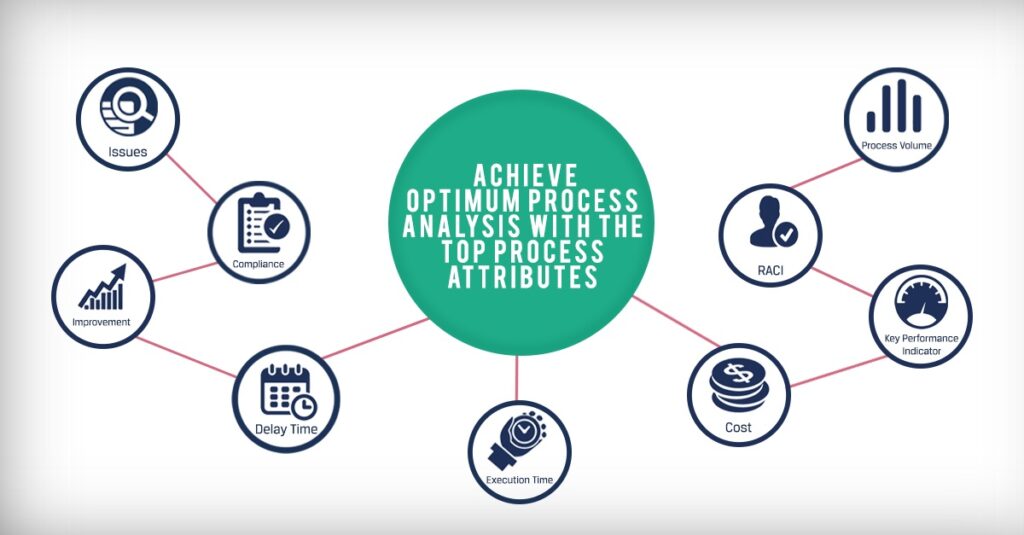It is important for organisations that aspire to have a successful continuous business improvement to have an in-depth understanding of the organistation’s business processes. This knowledge and understanding is important for creating the right improvement decisions and effectively manage the change.
To achieve the best outcome for process analysis during process improvement projects, business leaders should understand the importance of having the right process characteristics and standards that comes along with it. In this article, we will introduce the top process attributes that will help business improvement teams to achieve an efficient and effective process analysis.
Every process in an organisation is believed to have its own characteristics that relate to efficiency of doing it and effectiveness in its results. Each process is a contributor of a bigger result which helps the organisation achieve its goals and support its objective in providing incremental value for the customers. These processes should be analysed well, in order to keep track of its progress and relevance to the current goals
In our previous blog post <link to 4+2 Must Have Process Attributes>, we introduced 4 of the most important process attributes in achieving process analysis such as Roles, Documents, Applications and Tasks and this article will best supplement the aforementioned attributes.
Task Value. Analysts should identify whether the tasks within the processes are adding value if not to the customers, then it must be adding value to the business. The Customer Value-adding tasks be directly and indirectly affecting the customer and these are important for keeping the customers loyal to the company or to gather more customers. The Business Value-adding tasks are the essential tasks for conducting business. One task may not be adding value to the customer but it should make the organisation or the company more credible for conducting business. Tasks that make up the processes should all be value-adding either to the customers or to the business.
Business Rules. This attribute can greatly help people involved within the processes as it sets different standards that would influence the step-by-step progress in each process. The business rules should underpin the business processes with the benefit of removing the reliance to the individual’s decision making capability that may put the whole process at risk. The business rules set by the management should be supportive to achieving goal of the business process.
Key Performance Indicator. This well-defined measure is important for Analysts to track and assess each activity done in the process. It keeps track of the progress of the people involved in the system and assess the performance of the whole process. A KPI is an important baseline for the success level of the objective set by the organisation. Setting KPIs can provide insights that would bring the whole organisation to the same direction and therefore get the optimum improvement initiative done successfully.
Process Frequency and Volume. Process Frequency highlights how often this process is executed where as Process Volume highlights the number of times that the process is done on a specific time (frequency). This is important for process analysis since the high volume and high frequency processes should be given a high priority for analysis and improvement as the improvements in these processes will provide the biggest BANG for your BUCK!..
Time.. Time is valuable in every business process and it is an input that can define a process’ efficiency and cost. Analysts should capture execution time and delay time data in order to understand the total cycle time of the process. This data will help understand the total efficiency of the process.
Cost. Everything you do in a business incur cost therefore any significant change in this input can define a process’ efficiency. Senior management is always on the lookout for the process’ cost in order to identify areas to cut costs and improve productivity. In order to calculate the cost for any process, the analysts must capture Role, Time, Task, Volume and Frequency within the process and apply Activity Based Costing principles.
RACI.. It helps identify the roles of various participants in completing a certain task within a business process. RACI stands for Responsible, Accountable, Consulted and Informed. Responsible is the person assigned to complete the task, Accountable is the final authority and the person accountable for the successful completion of the process, the Consulted is the person where advice is taken from before or during the performance of the task, and the Informed is the person that should be kept up-to-date often on the completion of the task. If RACI is maximised, miscommunication can be avoided since there is a clear definition of roles and responsibilities. When everyone is aware of their responsibilities then they are aware of the consequences that could happen when certain tasks are not accomplished but most certainly, they are informed of what to do and what not given their roles.
These are only few of the most important attributes that would help analysts or project leaders in achieving optimum process analysis. Taking these attributes into account would be useful when planning for an improvement initiative or looking into significant changes in the process being implemented. If you are interested in making the most in your process analysis, make sure to watch how PRIME BPM can help achieve your process improvement goals through our product demo here ===> WATCH DEMO.


